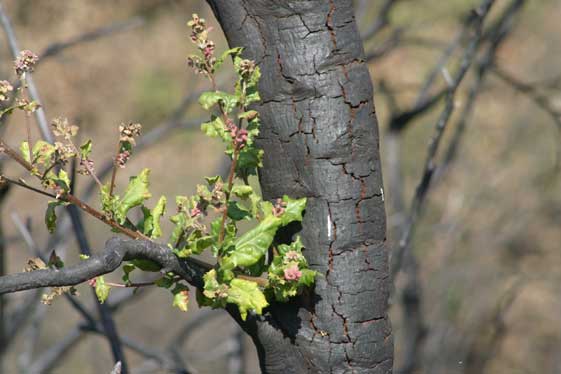Station Fire Burn Areas Begin Their Own Recovery
by Cliff and Gabi McLean, Natural Science Section
(reprinted with permission from the Southern Sierran, Vol. 65 No. 12, December, 2009, Angeles Chapter of the Sierra Club)

Photo by Cliff McLean
|
All of us who love to spend time in the San Gabriel Mountains were justifiably distressed when 161,000 acres burned in the recent Station Fire. Action-oriented Sierra Clubbers and others are eager to get out and contribute to the recovery of the burned areas of the Angeles National Forest. The mountains, however, have already begun their own recovery. In fact, with reasonable rains, they promise to provide a spectacular show next spring. Although we call it the Angeles National Forest, the majority of the San Gabriel Mountains are not forested. They are covered by chaparral, which is the most widespread plant community in California. Chaparral consists primarily of woody, hard-leaved, often spiny shrubs that grow up to about 20 feet tall. If you try to go off-trail in chaparral, you will quickly find it to be nearly impenetrable. Chaparral is well adapted to survive infrequent fires and does a remarkable job of recovering after it is burned. Most of the shrubs can grow new sprouts from their unburned roots. They can grow quickly because of the energy stored in the roots. Just two months after the fire, lots of green shoots are emerging around the blackened shrub skeletons. Chamise, mountain mahogany, scrub oak, coffeeberry, poison oak, and some manzanita and ceanothus are examples of these “resprouters”. Other shrubs have seeds that lie dormant in the soil waiting for the next fire to create the environment conducive to germination. Fire opens the canopy, providing sunlight where previously there was only shade. The heat of the fire or chemicals in the smoke or charred wood prepare the seed coats to germinate with the first rain. Bush poppy and other manzanitas and ceanothus species are among these “seeders”. Since we have already had showers this year, we can see tiny seedlings coming up to replace their now dead parents, but growing much more slowly than the resprouting shrubs. A number of chaparral shrubs can resprout and reseed, which increases their ability to recover. These shrubs include Yerba santa, redberry, and many of the sages, buckwheats, and currants. It has often been said that chaparral is fire adapted and, as such, needs to burn periodically. But, being prepared for fire does not mean that they need fire. We all have fire insurance on our houses, but we don’t really want them to burn. |
The relatively rapid recovery of chaparral shrubs is reassuring to see, but the wildflowers that follow a fire are spectacular. In mature chaparral, there isn’t much space for smaller annuals or perennials. When the space is opened by a fire, the wildflower “go wild” with wonderful displays of color, often covering whole hillsides. These “fire-followers”, including whispering bells, white pincushion, some phacelias and lupines, and especially fire poppy, are seen in such profusion only in the first spring after a fire. Like some of the shrubs, their seeds can lie dormant in the soil for decades. To add to this display, some of the more common wildflowers, like fiddleneck, suncup, popcorn flower, other lupines, and wild canterbury bells, are much more abundant after a fire. In addition to the chaparral, there were areas of real forest burned in the Station Fire. According to the just-released Station Fire Burned Area Emergency Response (BAER) Botany Assessment Report, only about four percent of the burned area was ponderosa & Jeffrey pine and mixed conifer forest. Most of that suffered only low-to-moderate intensity fires that burned the understory, with considerable tree canopy retained. Recovery of the understory will be much like that of chaparral, but replacement of dead pines by new seedlings will take a long time. About four percent of the burn was desert scrub, which will recovery more slowly than the chaparral. The fast-growing trees and shrubs of the streamside (riparian) habitats, which make up less than one percent of the burned area, can recover by resprouting. For those of us who want to help with the recovery, there will be many things to do, but the planting has already been taken care of by Mother Nature. After the rains next spring, we will be able to work on repairing trails and controlling invasive weeds that threaten the native plants. In the meantime we can help to beef up facilities in unburned areas to accommodate higher recreation usage during the recovery period. The Angeles Chapter of the Sierra Club has created the Angeles Forest Restoration Project, as a subcommittee of the Forest Committee, coordinated by Bob Cates. You can read about this project in the October issue of the Southern Sierran or online at https://angeles.sierraclub.org/blog/2009/09/ashes_angeles_activists_unite _restore_angeles_national_forest. |
Keywords: Gabi McLean, Cliff McLean, Gabriele McLean, Clifford McLean, Nature at Hand, Gabi Horn, Gabriele Horn, Plants of the San Gabriel Mountains: Foothills and Canyon, Interpretive Guide on CD, Plants of the San Gabriel Foothills and Canyons, California native plants, Pasadena, Los Angeles, Los Angeles County, San Gabriel Valley, Southern California, Covina, natural, nature photography, photograph, environmental education, naturalist, docent, hike, hiking, CD-ROM, California native garden, gardening, flowers, wildflowers, San Gabriel Mountains, Angeles National Forest, Station Fire, fire recovery